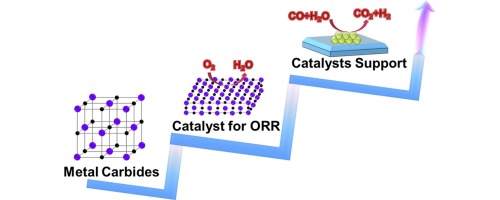当前位置:
X-MOL 学术
›
Nano Today
›
论文详情
Our official English website, www.x-mol.net, welcomes your
feedback! (Note: you will need to create a separate account there.)
Old materials with new properties II: The metal carbides
Nano Today ( IF 13.2 ) Pub Date : 2018-02-01 , DOI: 10.1016/j.nantod.2017.10.001 Tianchao Niu
Nano Today ( IF 13.2 ) Pub Date : 2018-02-01 , DOI: 10.1016/j.nantod.2017.10.001 Tianchao Niu

|
Abstract Metal carbides with particular phases have shown to be promising catalysts and supporting materials for high efficiency catalysis by choosing suitable decorating elements. Thinning metal carbides down to two-dimension can result in nontrivial properties such as superconductivity. The versatile chemistry of metal carbides offers the tunability for applications in Li-ion, Na-ion batteries and supercapacitors. However, from the point of view of surface and interface science, fundamental study at molecular/atomic levels which is crucial for understanding the origin of these superior properties, as well as the mechanism underlying interface catalysis is still missing. Furthermore, deviation of theoretical calculations from real conditions requires the building of model catalysts to mimic surface processes. In analogy with classical oxide/metal systems, we propose that scanning tunneling microscopy combined with in-situ chemical vapor deposition and molecular beam epitaxy would be powerful tools for both the controllable growth of two-dimensional metal carbides and the realization of atomic information during surface reactions.
中文翻译:

旧材料新特性二:金属碳化物
摘要 通过选择合适的装饰元素,具有特定相的金属碳化物已被证明是有前途的催化剂和高效催化载体。将金属碳化物减薄到二维可以产生非凡的特性,例如超导性。金属碳化物的多功能化学特性为锂离子、钠离子电池和超级电容器的应用提供了可调性。然而,从表面和界面科学的角度来看,分子/原子水平的基础研究对于理解这些优异性能的起源以及界面催化的机制至关重要。此外,理论计算与实际条件的偏差需要建立模型催化剂来模拟表面过程。
更新日期:2018-02-01
中文翻译:

旧材料新特性二:金属碳化物
摘要 通过选择合适的装饰元素,具有特定相的金属碳化物已被证明是有前途的催化剂和高效催化载体。将金属碳化物减薄到二维可以产生非凡的特性,例如超导性。金属碳化物的多功能化学特性为锂离子、钠离子电池和超级电容器的应用提供了可调性。然而,从表面和界面科学的角度来看,分子/原子水平的基础研究对于理解这些优异性能的起源以及界面催化的机制至关重要。此外,理论计算与实际条件的偏差需要建立模型催化剂来模拟表面过程。











































 京公网安备 11010802027423号
京公网安备 11010802027423号